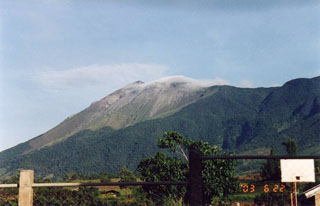Report on Kanlaon (Philippines) — 14 May-20 May 2025
Smithsonian Institution / US Geological Survey
Weekly Volcanic Activity Report, 14 May-20 May 2025
Managing Editor: Sally Sennert.
Please cite this report as:
Global Volcanism Program, 2025. Report on Kanlaon (Philippines) (Sennert, S, ed.). Weekly Volcanic Activity Report, 14 May-20 May 2025. Smithsonian Institution and US Geological Survey.
Kanlaon
Philippines
10.4096°N, 123.13°E; summit elev. 2422 m
All times are local (unless otherwise noted)
The Philippine Institute of Volcanology and Seismology (PHIVOLCS) reported that the five-minute eruption at Kanlaon on 13 May consisted of two successive ejections of incandescent material and an ash plume that rose possibly as high as 8 km above the crater rim; pyroclastic density currents descended the S flanks as far as 2 km. Ashfall impacted a total of 51 barangays in nine municipalities (four provinces). Sulfur dioxide emissions averaged 5,241 tonnes per day (t/d) that day. Satellite analysis indicated extensive drift of sulfur dioxide across the Philippines, Palawan Island, and N Borneo.
Activity continued during 14-20 May. Gas-and-steam plumes with occasional ash content drifted W and SW on 14 May. Diffuse gas-and-steam plumes rose as high as 100 m above the summit and drifted NW, W, and SW during the rest of the week. The seismic network recorded 2-16 daily volcanic earthquakes. Daily sulfur dioxide emissions ranged from 852 to 2,533 tonnes per day. The Alert Level remained at 3 (on a scale of 0-5); the public was warned to stay 6 km away from the summit and pilots were warned not to fly close to the volcano.
Geological Summary. Kanlaon volcano (also spelled Canlaon) forms the highest point on the Philippine island of Negros. The massive andesitic stratovolcano is covered with fissure-controlled pyroclastic cones and craters, many of which are filled by lakes. The largest debris avalanche known in the Philippines traveled 33 km SW from Kanlaon. The summit contains a 2-km-wide, elongated northern caldera with a crater lake and a smaller but higher active vent, Lugud crater, to the south. Eruptions recorded since 1866 have typically consisted of phreatic explosions of small-to-moderate size that produce minor local ashfall.
Source: Philippine Institute of Volcanology and Seismology (PHIVOLCS)

